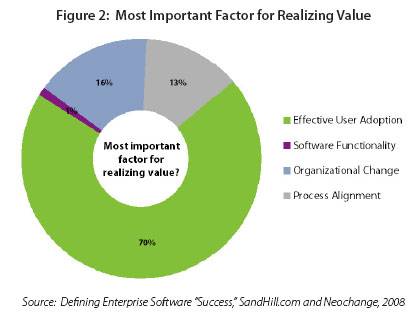Effective user adoption is the absolute best predictor of enterprise software success. That was one of the key takeaways for me from the OpenAir User Conference this week.

According to a study done by the Sand Hill Group and Neochange, the most critical factor (70% listed it as number 1) for software success and return-on-investment is effective user adoption.
Software functionality came in at 1% surprisingly, with organization change at 16% and process alignment at 13%. This is a remarkable result.

You can have the best software in the world, with the most sophisticated features, analytics and integration, blah blah blah – but if people don’t use it, it isn’t going to add value. I can’t tell you how many RFPs and software selection processes I’ve been involved with in prior lives that focus almost exclusively on tiny little features that few people will ever use. This study shows that focusing so much on features is missing the boat entirely.
This finding is very interesting for all kinds of applications, particularly enterprise apps but also consumer apps. Features very rarely make someone take to an application or not. Moreover, I doubt most software companies really take user adoption as a holistic approach into account when designing their applications.
If this trend is accurate (and my experience tells me it is), then I think it has very interesting ramifications on how software should be designed, sold and implemented. User adoption is typically something that comes at the end of a cycle. This says it should be one of the most important elements of the entire process. Please share any opinions or war stories that either confirm or refute this conclusion.

















